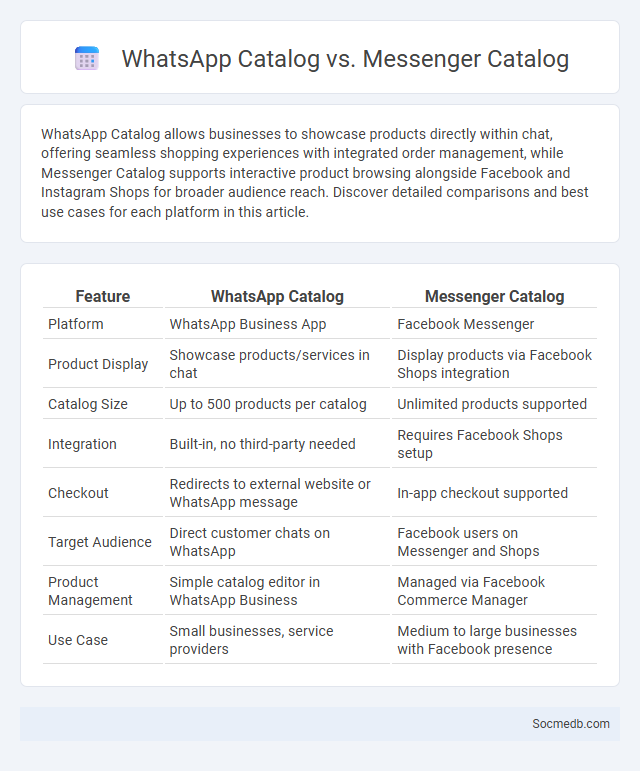
Photo illustration: WhatsApp Catalog vs Messenger Catalog
WhatsApp Catalog allows businesses to showcase products directly within chat, offering seamless shopping experiences with integrated order management, while Messenger Catalog supports interactive product browsing alongside Facebook and Instagram Shops for broader audience reach. Discover detailed comparisons and best use cases for each platform in this article.
Table of Comparison
| Feature | WhatsApp Catalog | Messenger Catalog |
|---|---|---|
| Platform | WhatsApp Business App | Facebook Messenger |
| Product Display | Showcase products/services in chat | Display products via Facebook Shops integration |
| Catalog Size | Up to 500 products per catalog | Unlimited products supported |
| Integration | Built-in, no third-party needed | Requires Facebook Shops setup |
| Checkout | Redirects to external website or WhatsApp message | In-app checkout supported |
| Target Audience | Direct customer chats on WhatsApp | Facebook users on Messenger and Shops |
| Product Management | Simple catalog editor in WhatsApp Business | Managed via Facebook Commerce Manager |
| Use Case | Small businesses, service providers | Medium to large businesses with Facebook presence |
Introduction to Digital Catalogs
Digital catalogs revolutionize how businesses showcase products on social media platforms, enabling you to present detailed images and descriptions that attract potential customers efficiently. Leveraging social media's targeting algorithms, digital catalogs increase visibility and engagement, driving higher conversion rates. Integrating these catalogs with shopping features simplifies the purchasing journey, enhancing the overall customer experience.
Overview of WhatsApp Catalog
WhatsApp Catalog enables businesses to showcase their products or services directly within the app, enhancing customer interaction and simplifying the buying process. It supports multimedia content such as images, descriptions, and prices, allowing potential customers to browse offerings without leaving the chat interface. Integration with WhatsApp Business API further streamlines order management, boosting sales efficiency and customer engagement.
Overview of Messenger Catalog
Messenger Catalog allows businesses to showcase products directly within Facebook Messenger, enhancing customer interaction and sales potential. Your catalog integrates seamlessly with your Facebook Shop, enabling personalized recommendations and streamlined purchasing experiences. Efficient management of product listings in Messenger Catalog boosts user engagement and drives conversions through targeted, conversational marketing.
What is a Standalone Catalog?
A standalone catalog is a specialized digital product listing designed to operate independently from other platforms or websites, allowing businesses to showcase their inventory directly to customers. It often features detailed product descriptions, images, prices, and ordering options, streamlining the shopping experience without relying on third-party marketplaces. By using a standalone catalog, your brand can maintain full control over customer interactions, data, and sales processes, enhancing engagement and conversion rates.
Key Features Comparison
Social media platforms vary widely in key features such as content formats, audience reach, and engagement tools, with Instagram emphasizing visual storytelling through images and reels, while Twitter prioritizes real-time updates and concise messaging. Facebook offers robust community-building options and detailed targeting for ads, whereas LinkedIn specializes in professional networking and industry insights. Understanding these differences helps you choose the right platform to maximize your social media strategy and connect effectively with your target audience.
Ease of Setup and Integration
Social media platforms offer user-friendly interfaces that streamline the setup process, allowing individuals and businesses to create profiles and pages within minutes. Seamless integration with various third-party tools, such as customer relationship management (CRM) systems and marketing automation software, enhances efficiency and data synchronization. This ease of setup and integration enables quick deployment of social media strategies, maximizing engagement and reach across multiple channels.
User Experience and Accessibility
Social media platforms enhance user experience by implementing intuitive navigation, personalized content feeds, and responsive design that adapts seamlessly across devices. Accessibility features such as screen reader compatibility, keyboard navigation, and alternative text for images ensure inclusivity for users with disabilities. Optimizing load times and providing customizable interface settings further improve engagement and satisfaction across diverse user groups.
Business Tools and Analytics
Social media business tools provide powerful analytics that track engagement, audience demographics, and campaign performance, enabling data-driven decisions for growth. Platforms like Facebook Insights, Twitter Analytics, and LinkedIn Business offer detailed reports to optimize your marketing strategy and boost ROI. Using these tools, you can tailor content more effectively to reach your target audience and enhance overall brand visibility.
Limitations and Drawbacks
Social media platforms often contribute to privacy concerns due to widespread data collection and potential misuse, exposing users to security risks. The algorithms driving content can create echo chambers, reducing exposure to diverse perspectives and exacerbating misinformation. Overuse of social media is linked to mental health issues such as anxiety, depression, and decreased self-esteem, particularly among younger demographics.
Which Catalog is Best for Your Business?
Choosing the best social media catalog for your business depends on your target audience, product type, and marketing goals. Facebook Catalogs offer seamless integration with Instagram Shopping, ideal for visual products and direct sales through social platforms. Shopify's product catalog is best for businesses needing centralized inventory management with social media advertising across multiple channels.
 socmedb.com
socmedb.com